Radar Error Correction Method Based on Improved Sparrow Search Algorithm
Abstract
:1. Introduction
2. Radar Measurement Error Model
3. Improved Sparrow Search Algorithm
3.1. Sparrow Search Algorithm
3.2. Improved Sparrow Search Algorithm
3.2.1. Elite Chaotic Reverse Learning Strategy
3.2.2. Producer–Scrounger Adaptive Adjustment Strategy
3.2.3. Osprey Global Exploration Strategy
3.2.4. Dynamically Selected Adaptive t-Distribution Disturbance
3.2.5. Improved Sparrow Search Algorithm
- The initialization of the algorithm, randomly generating candidate populations, using chaotic mapping and reverse learning to expand the population range, sorting and selecting well-performing individuals as the initial sparrow population.
- Calculate individual fitness value and location.
- Adaptively adjust the number of producers and scroungers according to the iteration schedule.
- Update the position of producers according to the osprey global search strategy and update the position of scroungers and guards according to the sparrow search mechanism.
- The dynamic selection of the adaptive t-distribution perturbation strategy was used to accelerate the convergence speed and further find the optimal individual, calculate the individual position and fitness values after the disturbance.
- Determine whether the algorithm has reached the maximum number of iterations. If it has reached the maximum number of iterations, the current optimal solution is output as the radar systematic error estimation result; otherwise, return to step 2.
4. Simulation Verification and Analysis
5. Conclusions
Author Contributions
Funding
Institutional Review Board Statement
Informed Consent Statement
Data Availability Statement
Acknowledgments
Conflicts of Interest
References
- Yan, Y. Noise Suppression and Weak Signal Detection in Sea Clutter. Ph.D. Thesis, Nanjing University of Information Science and Technology, Nanjing, China, 2023; pp. 1–2. [Google Scholar]
- Wen, D.; Yi, H.; Zhang, W.; Xu, H. 2D-Unitary ESPRIT Based Multi-Target Joint Range and Velocity Estimation Algorithm for FMCW Radar. Appl. Sci. 2023, 13, 10448. [Google Scholar] [CrossRef]
- Ishtiaq, S.; Wang, X.; Hassan, S.; Mohammad, A.; Alahmadi, A.A.; Ullah, N. Three-Dimensional Multi-Target Tracking Using Dual-Orthogonal Baseline Interferometric Radar. Sensors 2022, 22, 7549. [Google Scholar] [CrossRef] [PubMed]
- Li, Z.; Cheng, T.; Heng, S. Real-time dwell scheduling algorithm for phased array radar based on a backtracking strategy. IET Radar Sonar Navig. 2022, 17, 261–276. [Google Scholar] [CrossRef]
- Liu, H.; Pu, Y.; Wang, H.; Chen, S.; Huang, Y. A data-driven systematic error estimation method for radar systems. J. Command. Control 2021, 7, 107–112. [Google Scholar]
- You, H.; Jianjuan, X.; Xin, G. Radar Data Processing with Applications; Publishing House of Electronics Industry: Beijing, China, 2022. [Google Scholar]
- Dong, Y.; Zhang, Y. A Review of Radar System Deviation Accurate Registration Technology[J/OL]. Modern Radar. Available online: https://kns.cnki.net/kcms/detail/32.1353.TN.20220905.1215.002.html (accessed on 5 September 2022).
- Jiang, B.; Sun, L.; Zhou, W.; Wang, G.; Guan, J. Multi-target joint Error Estimation method for sea-facing radar based on AIS. Fire Control Command. Control 2017, 9, 25–29. [Google Scholar]
- Ren, W.; Zhou, Z.; Lü, S.; Shi, D. Position calibration technique of ship based on information of AIS. Syst. Eng. Electron. 2016, 38, 2381–2388. [Google Scholar]
- Li, S.; Su, Y. Registration for Multi-Sensor Networking System. Mod. Navig. 2021, 12, 438–443. [Google Scholar]
- Shang, J.; Yao, Y. Approach of system error registration for two-station coast radars for sea surface monitoring. J. Eng. 2019, 21, 7721–7725. [Google Scholar] [CrossRef]
- Chang, C.; Zhao, Q.; Yu, H.; Shen, L.; Dong, H. Approach for Space Registration Based on Extreme Learning Machines. Fire Control Command. Control 2017, 42, 10–13. [Google Scholar]
- Luo, J.; Shang, Y.; Zeng, H.; Wang, Y. Coast Radar Calibration Method Based on Automatic Identification System (AIS) Information. Telecommun. Eng. 2009, 49, 87–89. [Google Scholar]
- Pan, S.; Cha, H. A study on shipborne radar calibration method based on AIS. Ship Sci. Technol. 2009, 31, 101–104+127. [Google Scholar]
- Dong, Y.; Huang, G.; Li, B.; Zhang, L.; Guan, J. Error Analysis of Sea Radar System Based on AIS Auxiliary Information. Mod. Radar 2020, 42, 17–23. [Google Scholar]
- Zhang, Y.; Wang, G.H.; Chen, L. Real-Time Robust Estimation of Sensor Bias for Radar Network under Multi-Target Circumstance. Electron. Opt. Control 2013, 20, 5–7+27. [Google Scholar]
- Yuan, C. Research on Radar System Error Registration Technology Based on ADS-B. Master’s Thesis, Southern Medical University, Guangzhou, China, 2020. [Google Scholar]
- Ding, L.; Geng, F.; Chen, J. Radar Principle; Publishing House of Electronics Industry: Beijing, China, 2020; pp. 206–210. [Google Scholar]
- Dong, Y.; Huang, G.; Li, B.; Liu, N.; Chen, X. High precision error calibration method for radar based on AIS. Appl. Electron. Tech. 2019, 45, 75–79. [Google Scholar]
- Dong, Y.; Huang, G.; Li, B. A Calibration Method Based on Radar Coverage Partitioning Under Non-uniform System Errors. Electron. Opt. Control 2020, 27, 69–74. [Google Scholar]
- Wu, Z.Y.; Wang, M.H.; Zhang, R.P. ADS-B-Based Algorithm for Real-Time Optimal Estimation of Radar Biases. J. Southwest Jiaotong Univ. 2013, 48, 102–106+115. [Google Scholar]
- You, H.; Zhu, H.; Tang, X. Joint systematic error estimation algorithm for radar and automatic dependent surveillance broadcasting. IET Radar Sonar Navig. 2013, 7, 361–370. [Google Scholar] [CrossRef]
- Li, P.; Fan, E.; Yuan, C. A Specific Iterative Closest Point Algorithm for Estimating Radar System Errors. IEEE Access 2020, 8, 6417–6428. [Google Scholar] [CrossRef]
- Zhang, T.; Wu, R.; Lai, R.; Zhang, Z. Probability hypothesis density filter for radar systematic bias estimation aided by ADS-B. Signal Process. 2016, 120, 280–287. [Google Scholar] [CrossRef]
- Cheng, L.; Zhang, H.; Wei, D.; Zhou, J. An Indoor Tracking Algorithm Based on Particle Filter and Nearest Neighbor Data Fusion for Wireless Sensor Networks. Remote Sens. 2022, 14, 5791. [Google Scholar] [CrossRef]
- Lyu, X.Y.; Wang, J. Sequential Multi-sensor JPDA for Target Tracking in Passive Multi-static Radar with Range and Doppler Measurements. IEEE Access 2019, 7, 34488–34498. [Google Scholar] [CrossRef]
- Guo, S.; Mou, J.; Chen, L.; Chen, P. Improved kinematic interpolation for AIS trajectory reconstruction. Ocean. Eng. 2021, 234, 109256. [Google Scholar] [CrossRef]
- Zhu, T.; Chang, G.; Chen, C.; Zhang, L.; Zhang, S. Continuous modelling of global navigation satellite system multipath errors for sidereal filtering. IET Radar Sonar Navig. 2020, 14, 303–312. [Google Scholar] [CrossRef]
- Luo, T.; Xie, J.; Zhang, B.; Zhang, Y.; Li, C.; Zhou, J. An improved levy chaotic particle swarm optimization algorithm for energy-efficient cluster routing scheme in industrial wireless sensor networks. Expert Syst. Appl. 2024, 28, 122780. [Google Scholar] [CrossRef]
- Lei, M.; Wu, B.; Li, P.; Yang, W.; Xu, J.; Yang, Y. A fast convergence strategy based on gray wolf optimization algorithm for co-estimation of battery state of charge and capacity. Electrochim. Acta 2024, 474, 143525. [Google Scholar] [CrossRef]
- Yue, Y.; Cao, L.; Lu, D.; Hu, Z.; Xu, M.; Wang, S.; Li, B.; Ding, H. Review and empirical analysis of sparrow search algorithm. Artif. Intell. Rev. 2023, 56, 10867–10919. [Google Scholar] [CrossRef]
- Xue, J.; Shen, B. A novel swarm intelligence optimization approach: Sparrow search algorithm. Syst. Sci. Control Eng. 2020, 8, 22–34. [Google Scholar] [CrossRef]
- Liu, G.; Wu, Q.; Wang, G.; Jin, P. A Improved Logistic Chaotic Map and Its Application to Image Encryption and Hiding. J. Electron. Inf. Technol. 2022, 44, 3602–3609. [Google Scholar]
- Chen, L.; Song, N.; Ma, Y. Harris hawks optimization based on global cross-variation and tent mapping. J. Supercomput. 2022, 79, 31–39. [Google Scholar] [CrossRef]
- Feng, J.; Zhang, J.; Zhu, X.; Lian, W. A novel chaos optimization algorithm. Multimed. Tools Appl. 2017, 76, 17405–17436. [Google Scholar] [CrossRef]
- Liu, X. Research on Deployment Algorithm of Underwater Sensor Network. Master’s Thesis, Jilin University, Changchun, China, 2023. [Google Scholar]
- Wu, D.; Rao, H.; Wen, C.; Jia, H.; Liu, Q.; Abualigah, L. Modified Sand Cat Swarm Optimization Algorithm for Solving Constrained Engineering Optimization Problems. Mathematics 2022, 10, 4350. [Google Scholar] [CrossRef]
- Dehghani, M.; Trojovský, P. Osprey optimization algorithm: A new bio-inspired metaheuristic algorithm for solving engineering optimization problems. Front. Mech. Eng. 2023, 8, 1126450. [Google Scholar] [CrossRef]
- Yang, X.; Liu, J.; Liu, Y.; Xu, P.; Yu, L.; Zhu, L.; Chen, H.; Deng, W. A Novel Adaptive Sparrow Search Algorithm Based on Chaotic Mapping and T-Distribution Mutation. Appl. Sci. 2021, 11, 11192. [Google Scholar] [CrossRef]
- Zhang, W.; Liu, S. Improved sparrow search algorithm based on adaptive t-distribution and golden sine and its application. Microelectron. Comput. 2022, 39, 17–24. [Google Scholar]
- Li, J.; Zhao, C.; Chen, J.; Zhao, R. A Modified Generalized Least Square Registration Algorithm on WGS-84 Coordinate. J. Shanghai Jiaotong Univ. 2016, 50, 771–775. [Google Scholar]
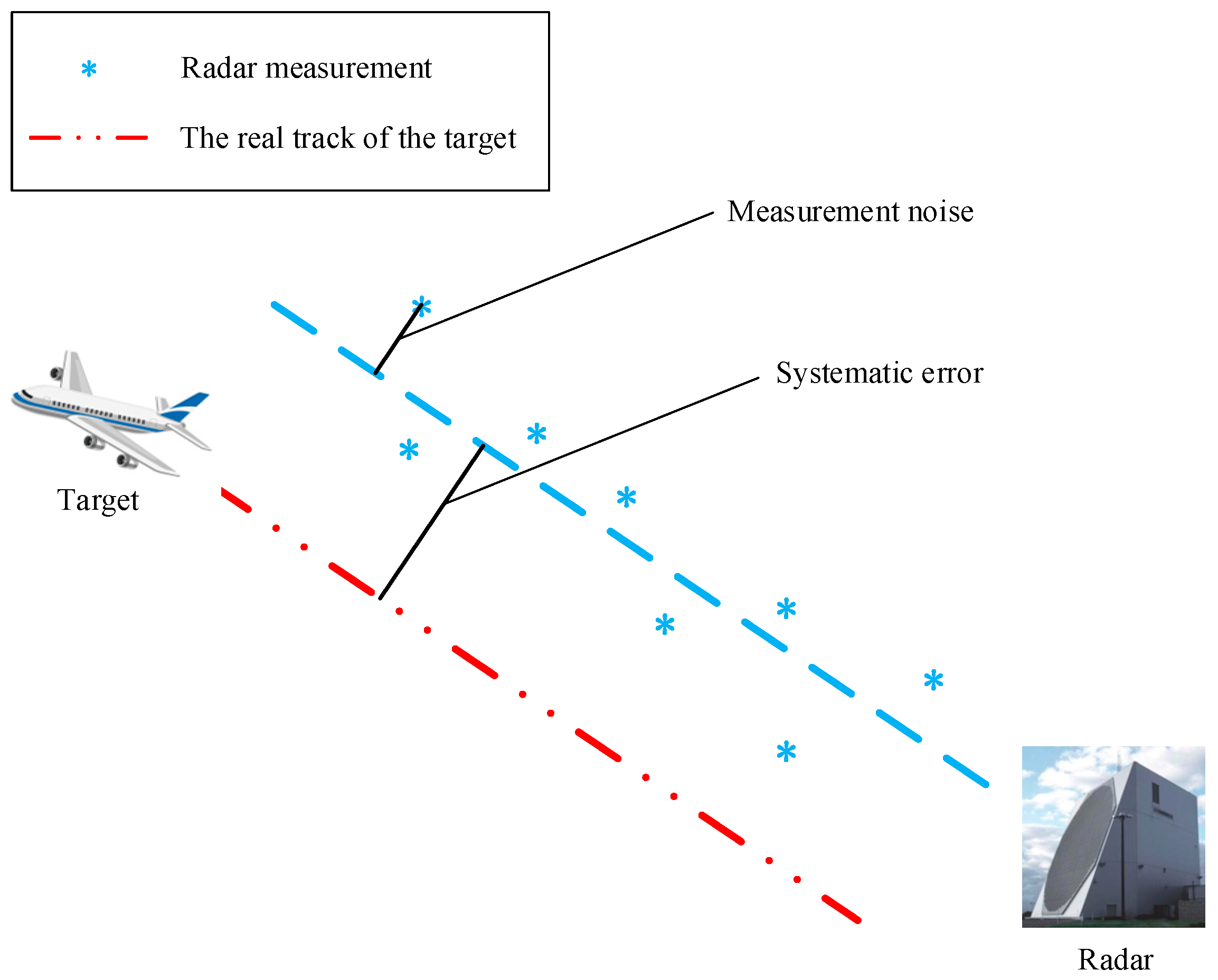
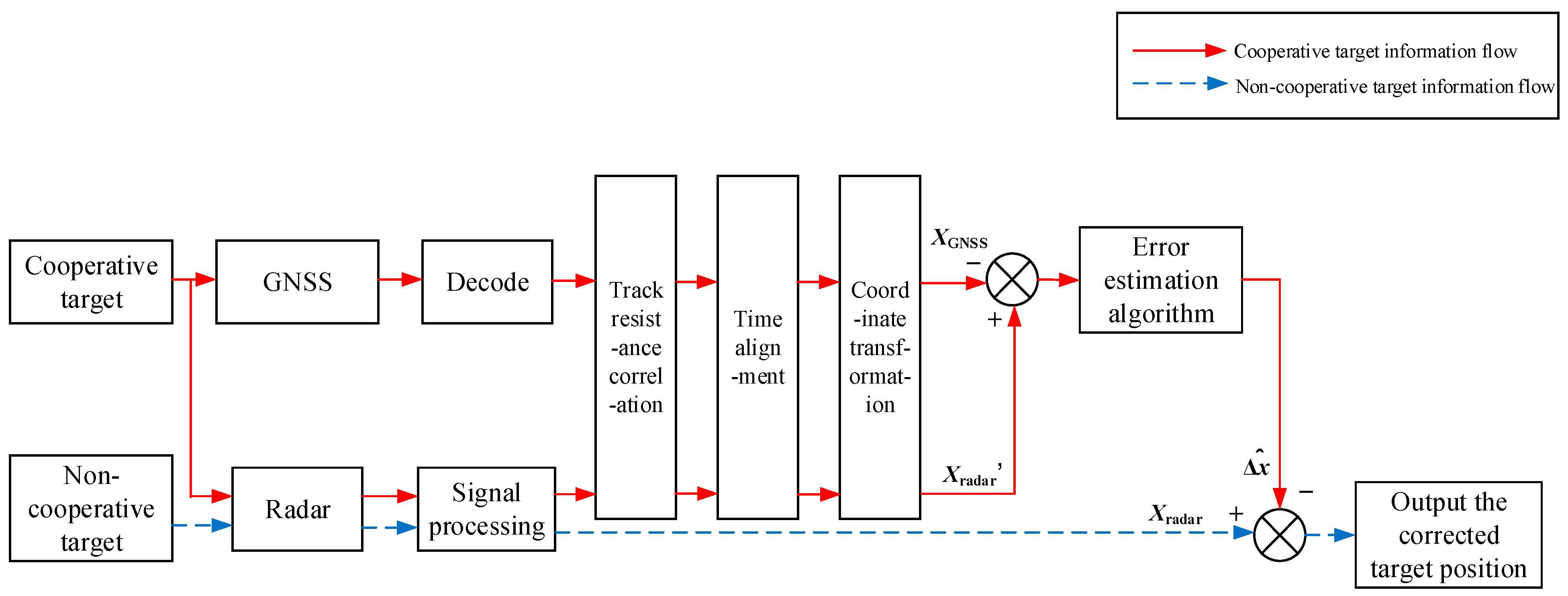
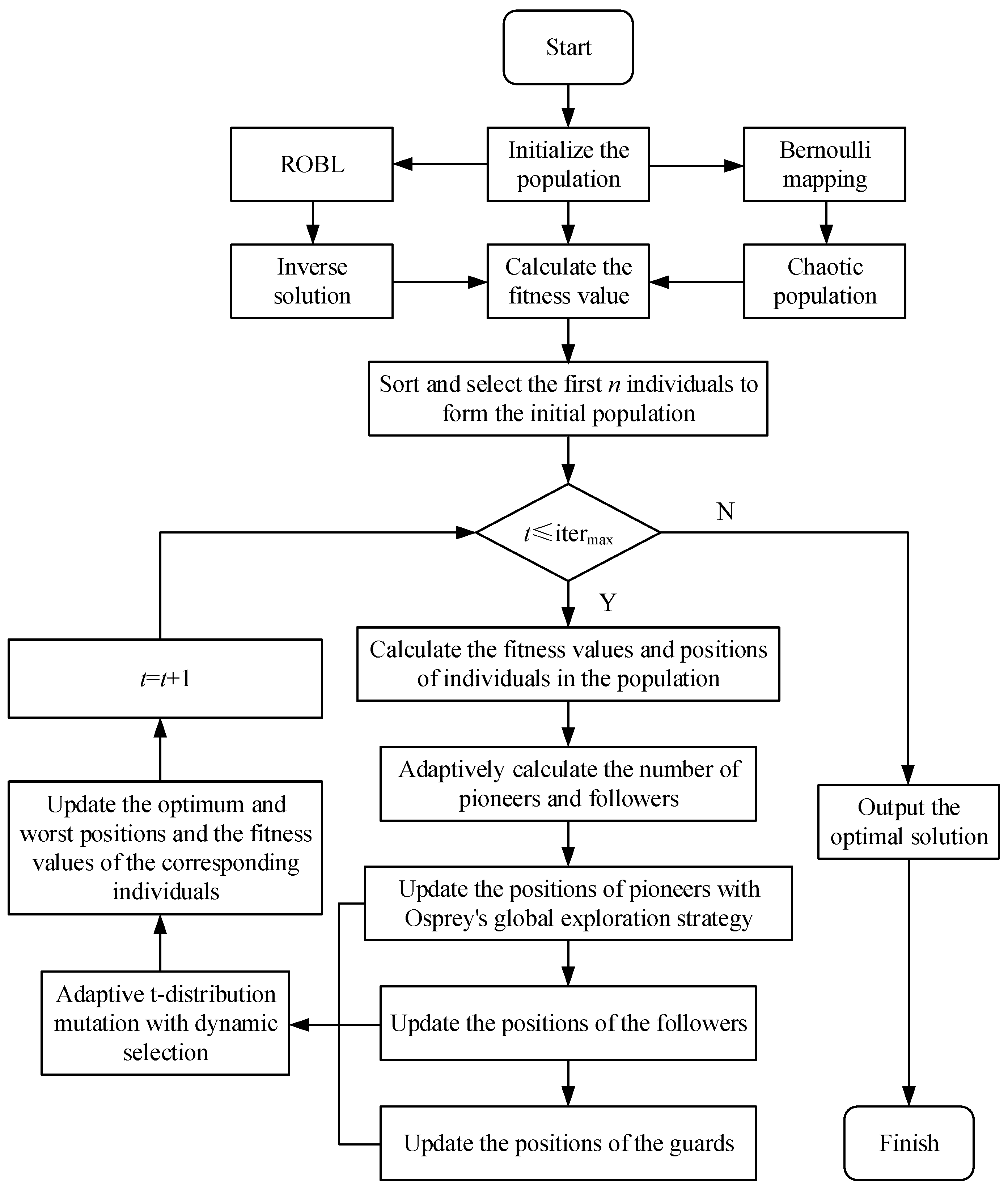
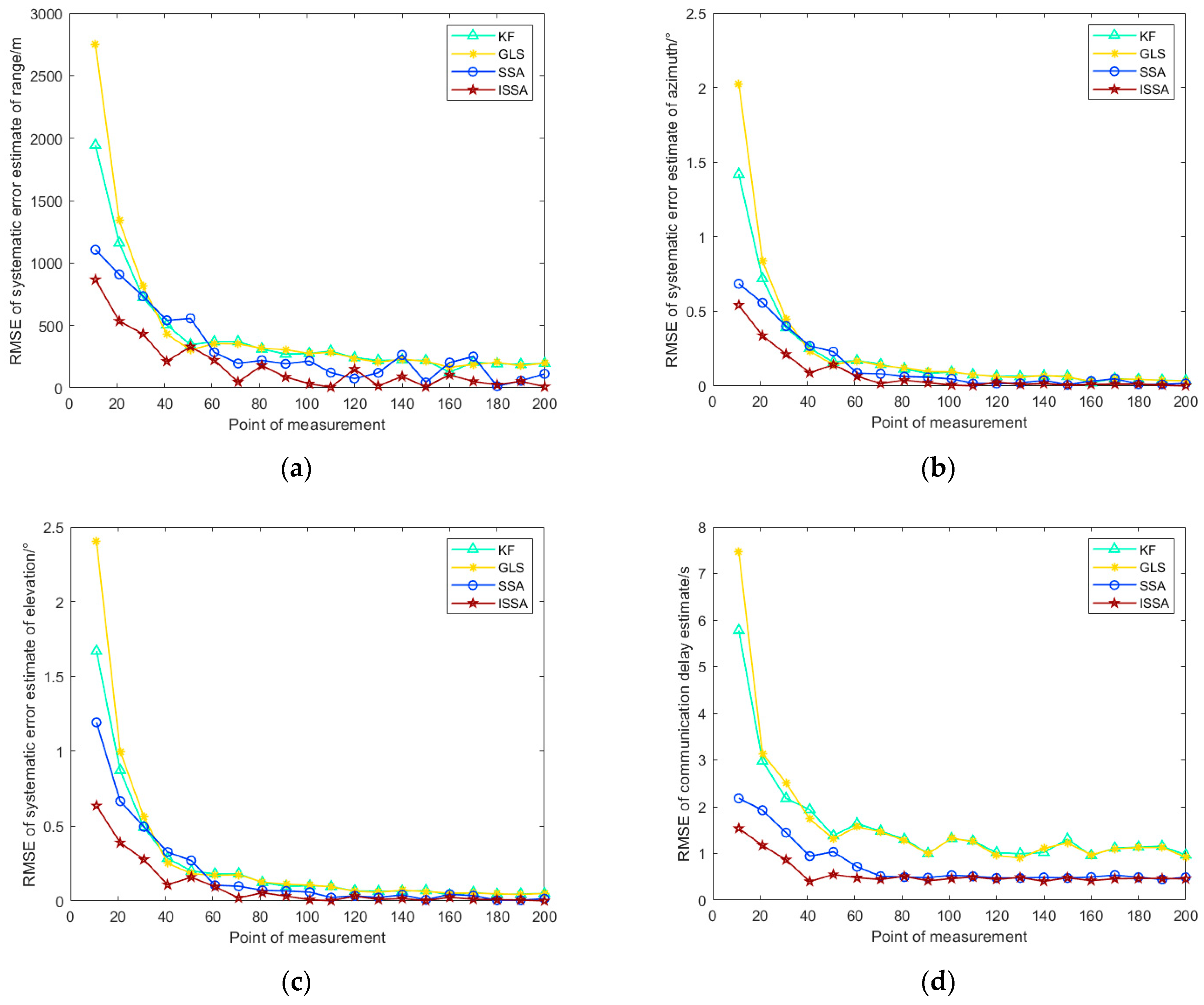
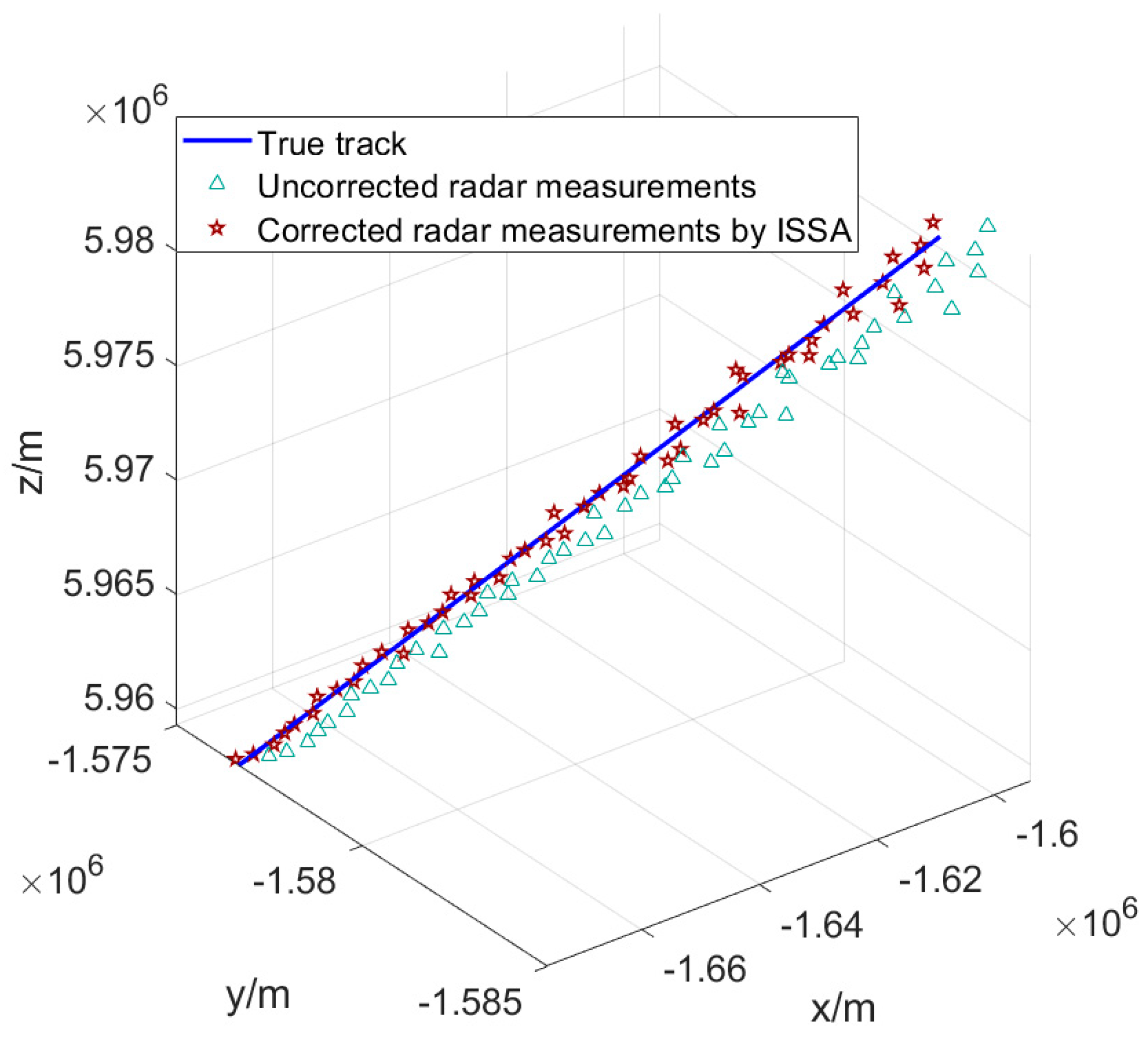

| Simulation Parameter | Symbol | Value |
|---|---|---|
| Radar geographic coordinates | (68.923°, −137.259°, 51.856 m) | |
| Range systematic error | 1300 m | |
| Azimuth systematic error | 0.498° | |
| Elevation systematic error | 0.544° | |
| Communication delay | 1 s | |
| Measurement noise of range | 80 m | |
| Measurement noise of azimuth | 0.2° | |
| Measurement noise of elevation | 0.2° |
| Evaluation Index | Error Estimation Algorithm | ||||
|---|---|---|---|---|---|
| KF | GLS | SSA | ISSA | ||
| (m) | RMSE | 204.49 | 198.62 | 148.11 | 77.44 |
| (°) | RMSE | 0.0364 | 0.0352 | 0.0216 | 0.0075 |
| (°) | RMSE | 0.0463 | 0.0450 | 0.0243 | 0.0098 |
| (s) | RMSE | 0.9195 | 0.8973 | 0.4844 | 0.4667 |
| Average time consuming(s) | 0.0072 | 0.0111 | 0.8206 | 0.4687 | |
Disclaimer/Publisher’s Note: The statements, opinions and data contained in all publications are solely those of the individual author(s) and contributor(s) and not of MDPI and/or the editor(s). MDPI and/or the editor(s) disclaim responsibility for any injury to people or property resulting from any ideas, methods, instructions or products referred to in the content. |
© 2024 by the authors. Licensee MDPI, Basel, Switzerland. This article is an open access article distributed under the terms and conditions of the Creative Commons Attribution (CC BY) license (https://creativecommons.org/licenses/by/4.0/).
Share and Cite
Liu, Y.; Shi, Z.; Fu, B.; Xu, H. Radar Error Correction Method Based on Improved Sparrow Search Algorithm. Appl. Sci. 2024, 14, 3714. https://doi.org/10.3390/app14093714
Liu Y, Shi Z, Fu B, Xu H. Radar Error Correction Method Based on Improved Sparrow Search Algorithm. Applied Sciences. 2024; 14(9):3714. https://doi.org/10.3390/app14093714
Chicago/Turabian StyleLiu, Yifei, Zhangsong Shi, Bing Fu, and Huihui Xu. 2024. "Radar Error Correction Method Based on Improved Sparrow Search Algorithm" Applied Sciences 14, no. 9: 3714. https://doi.org/10.3390/app14093714





